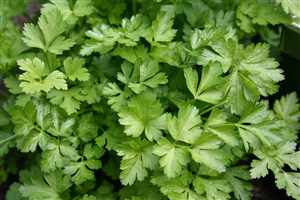Parsley (Petroselinum hortense, sativum)
Main Facts about Parsley

Using Parsley
High chlorophyll content works to absorb odors, making it great for bad breath and after eating garlic. Parsley seed was used traditionally as a carminative to decrease flatulence and colic pain. An extraction from the herb has been used as a diuretic and the juice to treat kidney ailments. Parsley oil also has been used to regulate menstrual flow and is purported to be an abortive. Bruised leaves have been used to treat tumors, insect bites, lice, skin parasites, and contusions. The essential oil, Eugenol, present in this herb has been in therapeutic application in dentistry as a local anesthetic and anti-septic agent for teeth and gum diseases. Eugenol has also been found to reduce blood sugar levels among diabetics; however, further detailed studies required to establish its role. Eating Parsley is helpful in maintaining bone health and for ostheoporosis prevention.Caution!
Adverse effects from the ingestion of parsley oil include headache, giddiness, loss of balance, convulsions, and renal damage. Parsley should not be consumed in large amounts or as a drug or supplement by pregnant women or while breastfeeding. Parsley oil contains furanocoumarins and psoralens, which may lead to extreme photosensitivity if used orally.Cooking with Parsley
Great for eating raw, juicing, blending or tea. In foods and beverages, parsley is widely used as a garnish, condiment, food, and flavoring.How to grow Parsley
Parsley is an annual in the North, growing from spring until freezing weather. In milder climates, it is frost-proof and lives through winter. The second spring after planting, the plant blooms and goes to seed. Grow near roses, asparagus and other garden plants to keep bugs away. As with most herbs, parsley does best in a sunny area which receives direct light for 6-8 hours a day, although it can tolerate some light shade. Plants will be more productive if grown in well drained soil that is fairly rich in organic matter, with a pH range of 6.0-7.0. Although germination is notoriously slow, seed propagation is the easiest way to start plants. To help hasten the process, soak the seeds in warm water for up to twenty-four hours prior to planting. Seeds can be started indoors in the late winter approximately 6-8 weeks ahead of the last frost date. Seeds can also be sown directly in the ground where they are to be grown, after danger of spring frosts has passed. Water deeply at least once a week to insure the roots are receiving enough moisture during the growing season. Parsley is an easy herb to grow indoors as long as it has a bright location and holes in the bottom of the pot to insure good drainage.Parsley Toxic Look-alikes
Aethusa cynapium (Dog poison, Fool's parsley, Small hemlock) may be distinguished from parsley by the shiny, yellow-green underside of the leaves, which are dull in parsley, and the white flowers, which are yellowish in parsley. Similarly, collectors should be aware of Conium maculatum (Poison hemlock, Water hemlock, Poison parsley) and Cicuta maculata (Water hemlock). Poison hemlock is a much larger plant than common parsley. Poisonings have occurred when its leaves of were mistaken for parsley and the seeds for anise. Symptoms of poisoning include vomiting, diarrhea, weakness, paralysis, weak pulse, dilated pupils, convulsions.| Onion |
Passionflower
|